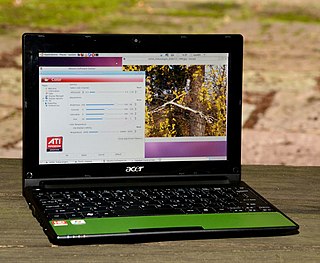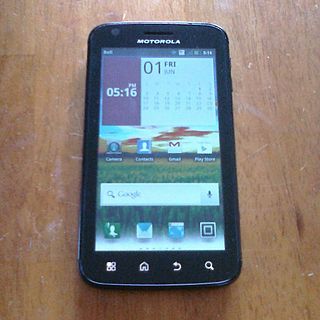
Kodi is a free and open-source media player and technology convergence software application developed by the Kodi Foundation, a non-profit technology consortium. Kodi is available for multiple operating systems and hardware platforms, with a software 10-foot user interface for use with televisions and remote controls. It allows users to play and view most streaming media, such as videos, music, podcasts, and videos from the Internet, as well as all common digital media files from local and network storage media, or TV gateway viewer.

A home theater PC (HTPC) or media center computer is a convergent device that combines some or all the capabilities of a personal computer with a software application that focuses on video, photo, audio playback, and sometimes video recording functionality. Since the mid-2000s, other types of consumer electronics, including game consoles and dedicated media devices, have crossed over to manage video and music content. The term "media center" also refers to specialized application software designed to run on standard personal computers.

An ultra-mobile PC, or ultra-mobile personal computer (UMPC), is a miniature version of a pen computer, a class of laptop whose specifications were launched by Microsoft and Intel in Spring 2006. Sony had already made a first attempt in this direction in 2004 with its Vaio U series, which was only sold in Asia. UMPCs are generally smaller than subnotebooks, have a TFT display measuring (diagonally) about 12.7 to 17.8 centimetres, are operated like tablet PCs using a touchscreen or a stylus, and can also have a physical keyboard. There is no clear boundary between subnotebooks and ultra-mobile PCs, but UMPCs commonly have major features not found in the common clamshell laptop design, such as small keys on either side of the screen, or a slide-out keyboard.
The Classmate PC, formerly known as Eduwise, is Intel's entry into the market for low-cost personal computers for children in the developing world. It is in some respects similar to the One Laptop Per Child (OLPC) trade association's Children's Machine (XO), which has a similar target market. Although made for profit, the Classmate PC is considered an Information and Communication Technologies for Development project (ICT4D). Introduced in 2006, the device falls into the then popular category of netbooks.

Asus Eee is a family of products by AsusTek Computer Inc. The product family began with the release of the Eee PC subnotebook in 2007; since then, the product family has diversified into a number of PC form factors. According to the company, the name Eee derives from "the three Es," an abbreviation of its advertising slogan for the device: "Easy to learn, Easy to work, Easy to play".

The HP MediaSmart Server is a line of home servers sold by Hewlett-Packard, designed to run Microsoft's Windows Home Server operating system.

The HP Pavilion dv9000 was a model series of laptops manufactured by Hewlett-Packard Company that featured 16:10 17.0" diagonal displays.

Acer Aspire One is a line of netbooks first released in July 2008 by Acer Inc.

Boxee was a cross-platform freeware HTPC software application with a 10-foot user interface and social networking features designed for the living-room TV. It enabled its users to view, rate and recommend content to their friends through many social network services and interactive media related features.
The Dell Inspiron Mini Series is a line of subnotebook/netbook computers designed by Dell. The series was introduced in September 2008 amidst the growing popularity of low-cost netbook computers introduced by competitors.

HP Mini is a former line of small computers categorized as netbooks manufactured by Hewlett-Packard. They either contained a custom version of Ubuntu Linux, Microsoft Windows XP Home Edition or Windows 7 Starter operating system. Like most netbooks, they were not built with CD/DVD drives. They were announced from mid-2007, and marketed from 2008 through 2012.
The Adam Tablet is a tablet computer designed by Bangalore-based firm Notion Ink Design Labs. The worldwide launch occurred on December 18, 2010 via a video released by Notion Ink detailing their Eden Interface. On December 9 a limited number of devices were released for pre-order globally, followed by a larger pre-order starting January 9, 2011 and an open subscription pre-order from 11 January 2011. The Adam runs a customized version of Android 2.2 Froyo, and has released beta versions of Android 3.0 Honeycomb and Android 4.0 Ice Cream Sandwich The beta versions released were largely done through the efforts of volunteer developers. The Adam is set to be the first Android device marketed to contain Pixel Qi's low-power, dual-mode display. The device is one of several tablet form-factor devices to include a dual-core Nvidia Tegra 2 processor that can support 1080p video output mirroring.

The Motorola Atrix 4G is an Android-based smartphone developed by Motorola, introduced at CES 2011 along with the Motorola Xoom, Motorola Droid Bionic, and Motorola Cliq 2 on January 5, 2011. It was made available in the first quarter of 2011.

The Acer Iconia is a range of tablet computers from Acer Inc. of Taiwan.
The Samsung Galaxy R (Royal) (GT-I9103) is an Android smartphone that was announced by Samsung on August 10, 2011 as a variant to the Samsung Galaxy S II.
Lenovo’s line of Essential desktops is a collection of budget-conscious machines designed for consumers, and advertised as being "affordable, space saving, and energy efficient". The Essential desktop line is different from both Lenovo’s ThinkCentre line and Lenovo’s IdeaCentre line. Lenovo defines its ThinkCentre desktops as business-oriented computers, while the IdeaCentre desktops are meant primarily for entertainment. The Essential range of desktops can be categorized as being between the two – meant more for ordinary everyday use.
Lenovo smart televisions use the Android operating system and are marketed as the "LeTV" in Mainland China.

Surface 3 is a 2-in-1 detachable from the Microsoft Surface series, introduced by Microsoft in 2015. Unlike its predecessor, the Surface 2, Surface 3 utilizes an x86 Intel Atom system-on-chip architecture, or SoC, rather than a processor with ARM architecture such as the Nvidia Tegra that powered the Surface 2, and runs standard versions of Windows 8.1 or Windows 10.











